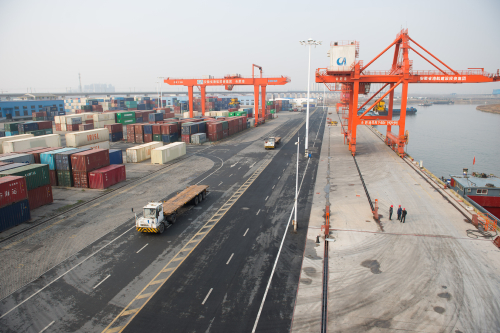|
 |
|
A STRONGER PORT: The second-phase project of the Hefei Port in east China's Anhui Province begins operations on January 7, increasing the throughputs of the port to 600,000 containers per year (DU YU) |
PMI Data
Chinese manufacturing activity waned slightly in December 2014, whereas activity in the service sector rose in the month, official data showed on January 1.
The manufacturing purchasing manager's index (PMI), a key measure of factory activity in China, posted a value of 50.1 in December, down from 50.3 in November, according to data released by the National Bureau of Statistics (NBS) and the China Federation of Logistics and Purchasing (CFLP).
A reading above 50 indicates expansion, while a reading below 50 represents contraction.
The slumping PMI showed the manufacturing sector does not have great upward momentum, though it is running stably, said Zhao Qinghe, a senior NBS statistician.
China is experiencing industrial restructuring, and prices of industrial products have been slumping, affecting the production and order sub-indices, Zhao said.
Deflation appears with signs of weak market demand, slumping industrial product prices and dropping profits, said Cai Jin, Vice Chairman of CFLP.
China's "new normal" of slower but higher quality growth will result in a moderate slowdown, but it does not mean the growth rate will continue to shrink for long; the growth rate will stabilize in the second quarter of 2015, Cai said.
Meanwhile, the PMI for the non-manufacturing sector rebounded to 54.1 in December from 53.9 in the preceding month.
Zhao said the non-manufacturing sector has been improving since the country mapped a series of measures to boost the service sector and upgrade industries.
Wu Wei, an analyst with China Logistics Information Center, said the service sector has been running healthily and plays a more important role than ever in providing jobs.
Overseas Ambition
Huawei, one of top Chinese hi-tech brands, exhibited over 100 products at the 2015 International Consumer Electronics Show (CES) that opened on January 6 in Las Vegas.
The showcased products include Huawei's latest flagship smartphones, wearable devices, tablets, mobile-access devices, home-access devices, smart home devices, OTT (Over The Top) and vehicle-mounted modules.
The company also introduced the start of the Hilink era--its strategy to offer fully integrated mobile Internet solutions to consumers all around the world as part of its commitment to bringing the latest technology to consumers and creating extraordinary connected experiences for people everywhere.
"The year 2014 saw our greatest achievements to date. Our strategy of focusing on premium mid-to-high-end products has borne fruit, with year-on-year smartphone sales increasing by 30 percent to over $11.8 billion," said Richard Yu, CEO of Huawei Consumer Business Group.
Huawei's global influence has continued to grow as it became the first Chinese mainland company to successfully enter the London-based consultancy Interbrand's Top 100 Global Brands of 2014, he added.
Founded in 1987 and headquartered in the southern Chinese city of Shenzhen, Huawei replaced Ericsson in 2012 as the world's largest telecommunications equipment maker. In 2014, Huawei's smartphone global shipment ranked third in the world.
Car Import in FTZ
On January 7, China (Shanghai) Pilot Free Trade Zone (FTZ) launched a pilot program on parallel imports of cars.
The program, green-lighted by a circular issued on January 7, will allow cars to be imported without getting authorization from carmakers and thus promise lower prices for Chinese buyers.
The Shanghai Commission of Commerce and the Shanghai FTZ Administrative Committee jointly issued the circular.
The circular has listed requirements for companies wishing to join the program, including those having engaged in car transaction for five years or more and reporting profits over the past three consecutive years.
The circular required participating companies to shoulder duties, including recall, after-sale service, repair guarantees and replacement or refunds for faulty products.
Cars imported through this channel must meet China's relevant quality and technical standards.
Gu Jun, deputy head of the Shanghai Commission of Commerce, said the pilot program would benefit the market competition and the pricing of cars.
| 